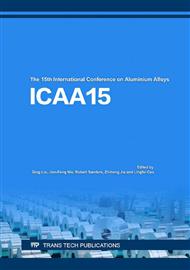p.471
p.479
p.485
p.492
p.498
p.508
p.514
p.522
p.530
Optimization for Anodizing Conditions of 5A06 Aluminum Alloy Based on Doehlert Design Matrix Method
Abstract:
The present study investigated the influence of intermetallic phases and anodizing parameters on anodic oxidation of 5A06 aluminum alloy by using Doehlert design matrix, in which the anodizing voltage, time and concentration of sulfuric acid were set as input variables while the quantity of electricity (Q) and the corrosion current (jcorr) were set as response values. The results showed that the residual particles after anodizing were mainly Si-containing phases. The thickness of anodic film increased linearly with the applied quantity of electricity and the anodic film exhibited high corrosion resistance when applied quantity of electricity increased more than 900C. Doehlert design matrix revealed that all regressions were significant, indicating that each second order model was adequate. The anodizing behavior and corrosion resistance could be predicted by the simulated model. An optimal anodizing parameters (16V, 20 min, 50g/L) were obtained by using desirability functions with satisfied degree of 0.987.
Info:
Periodical:
Pages:
498-507
Citation:
Online since:
November 2016
Authors:
Keywords:
Price:
Сopyright:
© 2017 Trans Tech Publications Ltd. All Rights Reserved
Share:
Citation:


